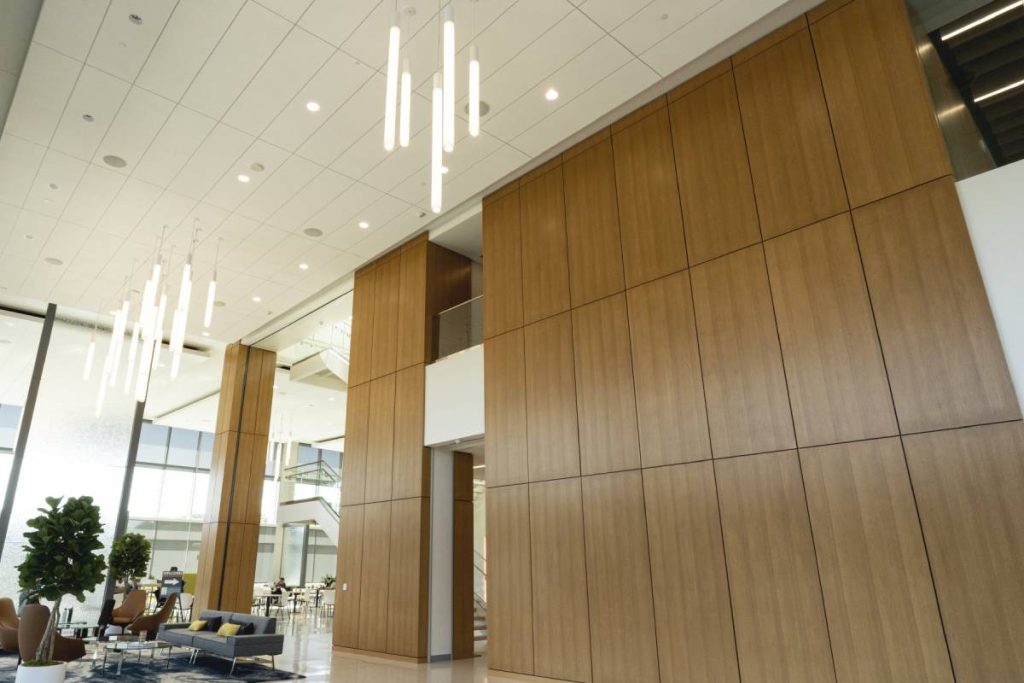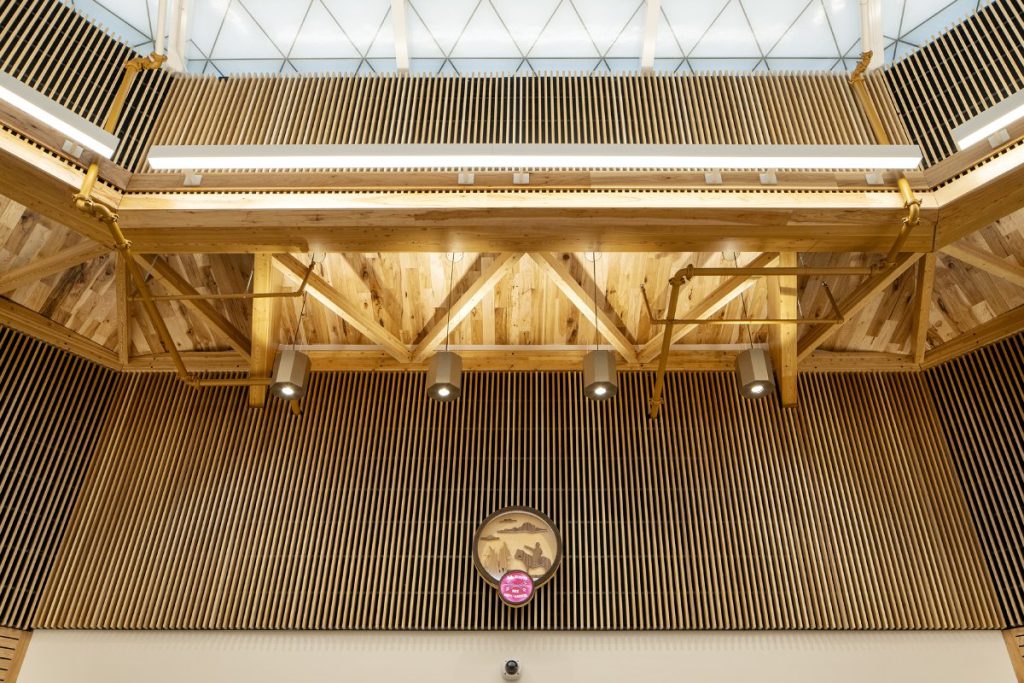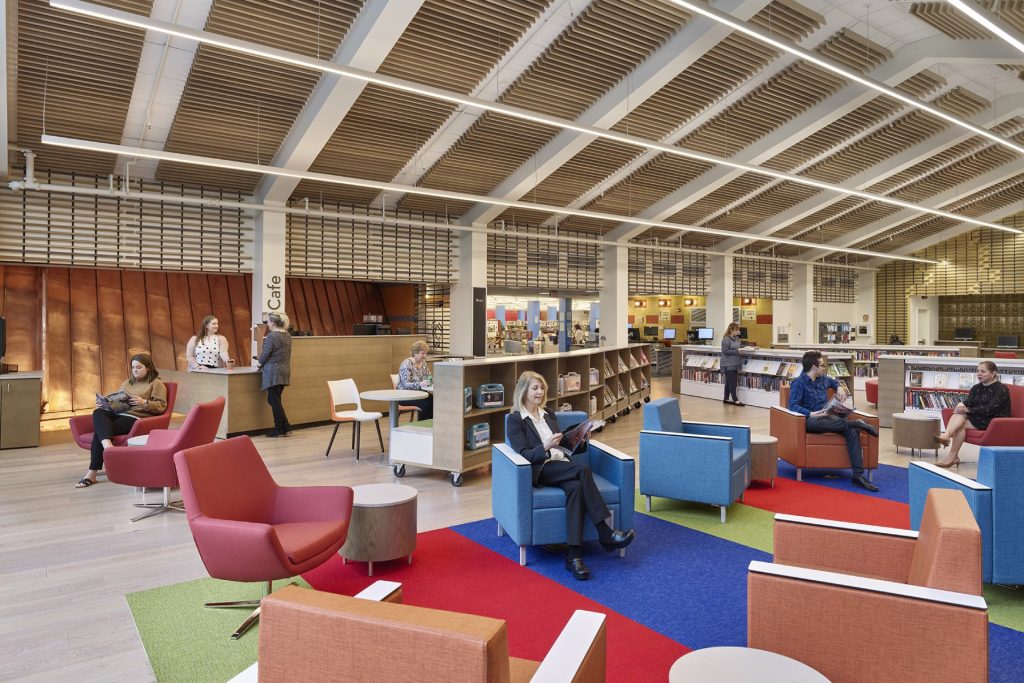
Modern Materials, Classic Beauty: The Evolution of Wall Cladding in Architecture
Today, wall cladding materials and systems are the new black. Wall cladding is a functional, fundamental design element for architects that adds visual and tactile beauty, supports acoustic performance, and enables sustainability in commercial interiors.
ASI Architectural leads the way with architectural cladding systems and modern wall panel materials that combine high performance with expressive beauty and elegance. Materials like wood veneer cladding, perforated wall panels, and acoustic wall panels offer personality, performance, and purpose – adding warmth, value, and style to any space. Interior cladding design must balance brand expression, sustainability goals, and acoustic performance to meet the needs of modern environments.
In this article we’ll cover the basics of architectural cladding – from stone to wood veneer. We’ll also discuss why architects are selecting wall cladding and the importance of customization to achieve signature aesthetics. Finally, we’ll showcase some of the modern architectural cladding systems from ASI Architectural.
Architectural Cladding: From Stone to Wood Paneling
First, let’s define architectural cladding. It’s any material or system attached to the outside or inside of a structure to provide protection, insulation, weatherproofing – or a combination of all three. It’s important to note that these architectural wall claddings have also developed strong decorative and expressive roles. When installed as interior wall paneling or applied to exterior walls, they can support acoustic performance, deliver unique textural finishes, and help brands tell their visual stories with more personality and purpose.
Architectural cladding has deep historical roots, with applications as functional as they are aesthetic. The history of architectural cladding includes:
Stone
Granite and limestone started out as protective materials for temples, fortresses and government buildings throughout ancient Egypt, ancient Greece, and early Europe. These stones were chosen not just for their practical uses of strength and durability but also for what they represented: permanence, power, and prestige. The stone’s natural density also offered a sense of insulation and protection when malleable materials were limited. As architectural designs became more advanced, master stonemasons sharpened their skills in cutting and shaping stone for more intricate uses, such as friezes, columns, and decorative facades. Stone has also played a symbolic and spiritual role in medieval and renaissance architecture, forming the foundation of churches, cathedrals, and civic monuments. Stone remains a popular material for architects today who are looking to add gravitas and a sense of timelessness to their designs.
Brick
Clay-fired brick has been a primary construction material since Mesopotamian times because of its modularity, strength, and fireproofing. Variations in local clay and firing methods gave regions their own visual identities throughout history, from the red brick of Georgian England to the sunbaked adobe of the American Southwest. Brickmaking’s standardization of form and firing during the Roman Empire made it central to monumental construction and decorative masonry. As bricklaying techniques developed, architects used brick not only for structural walls but for pattern, relief, and detailing that added rhythm and ornamentation to otherwise flat surfaces. In contemporary architecture, exposed brick is often used for its raw, industrial aesthetic and historical connotations.
Terracotta
Terracotta is a fired-clay material that has been used for utilitarian and decorative purposes since ancient times. The Italian term means “baked earth” and refers to roof tiles, wall cladding, wall panels, and sculptures. Its decorative nature was enhanced by the ease with which it could be ornamented. As a soft, plastic substance before firing, terracotta could be formed into delicate and elaborate details of facade, relief, and figural ornament. It was particularly used for this purpose during the Renaissance and Art Deco periods. Architects have often specified terracotta as a rainscreen cladding material due to its ability to resemble stone at a lower cost, the warm earth tones it can provide to a building, and its suitability to be cast in molds for complex, sculptural forms.
Decorative wood paneling
Architectural wood paneling has evolved from ornate historical designs into refined, modern systems that offer both texture and technical performance. As a result, it quickly became a mainstay in interior wall cladding systems throughout European architecture.
Early finishes on walls were structural and heavy, supporting the life of the building as much as the aesthetics. As building systems evolved, wood became a material of choice to make more complex, detailed, and delicate structures and finishes possible. Architects loved wood for its warm, organic feel and natural beauty. Its pliability allowed for incredible detail and design complexity as construction techniques improved. You can see this on display on ornately carved, inlaid, and molded wood interiors of the inside of the Sistine Chapel or Notre Dame in Paris.
Today’s architectural wall systems have broadened to support specific performance needs, like acoustics, environmental responsibility, and brand expression, all while maintaining the visual and tactile appeal of wood.
Architectural Veneer and Finishes Today
There are many modern decorative wall cladding options today, including wood veneer cladding, perforated wall panel systems, and composite wall panels. All provide options for architects to combine visual beauty, design flexibility, and performance needs in one solution. For instance, veneer wall panels offer a sleek, lightweight solution for achieving the look of solid wood while maintaining design flexibility and cost efficiency.
ASI Architectural has developed collections and solutions that use modern wall panel materials to support expressive wall cladding designs in commercial interiors. From fusion wall panels to linear wall panel systems to wood acoustic panels, ASI Architectural’s solutions deliver the beauty and warmth of wood as well as high performance in sound absorption, fire resistance, and indoor air quality.
Sustainable and Composite Cladding Solutions
Environmental impact is more than just a nice add-on for wall paneling and architectural cladding materials in the design and construction industry. Architects and consumers alike are expecting materials that meet high standards for impact and health.
ASI Architectural takes this responsibility to heart and has a full suite of sustainable cladding materials that have been designed for performance under pressure and for a reduced ecological footprint.
Green Materials and Eco Friendly Options
Architectural design and specification choices are increasingly focused on environmental impact and healthier interiors, including low-VOC finishes and recycled content. These are essential for both compliance and wellbeing.
Designing in Sustainability
Modern cladding options like wood fiber acoustic panels, composite veneers, and StrandTec panels not only meet certification standards like LEED, WELL, and Living Building Challenge, but they help reduce emissions and environmental impact. They are smarter alternatives to more resource-heavy products and eliminate dangerous legacy products like asbestos. Sustainable cladding materials are made with low-impact or recycled content materials and can offer alternatives to more traditional solutions.
ASI Architectural: Designed for the Environment
ASI Architectural’s commitment to the environment and sustainable interiors is the foundation for our entire portfolio of green building materials. Products in our collections are FSC certified, Red List Free, third-party tested, and compliant with the most stringent indoor air quality standards. Our reclaimed wood products even give a second life to precious old-growth wood with reclaimed wood wall cladding solutions. Read more about ASI reclaimed wood finishes here.
Architectural Cladding Options and Customization
Architects in the past were forced to make a choice between beautiful wall cladding materials and practical, sensible options. ASI’s view is that wall panel customization is a fundamental tool for creating an effective and memorable interior.
Customize Finishes, Geometry, and Texture
With the ASI Architectural design tool, architects can craft their aesthetic and achieve the ideal result with solutions including fusion wood panels, linear wall panel systems, or custom wood finishes to suit any concept.
Modularity Options for Increased Design Flexibility
ASI Architectural also has modular systems that architects can use to boost flexibility and creativity in solutions. Options include cube ceilings and grille panels. These can be re-purposed and applied to walls as vertical panels for both visual interest and acoustic management.
Acoustic Built-In
Effective acoustic wall treatment is essential in commercial interiors like offices, lobbies, and learning environments where sound clarity and comfort matter. Sound absorption is another key to consider. ASI Architectural also offers acoustic wall panels, perforated wall panels, and wood acoustic panels for a high NRC rating with a beautiful wall finish.
Collaborative Approach to Design
Customization is key in all modern architecture spaces, not just corporate environments or acoustically challenging interiors.
ASI Architectural is available to help architects with solutions at every phase of design and development, from initial 3D modeling and concept to execution and fabrication.
The Future of Wall Cladding and Materials
The future of modern architectural cladding is one where materials and wall panel solutions combine expressiveness and beauty with performance and sustainability.
For ASI Architectural, the future means redefining the standards for decorative wall cladding solutions. All of our wall panels and wall cladding materials are highly tactile, high-performing, and elevate any space they touch.
Products like fusion wall panels, wood veneer cladding, linear wall panels systems are expressive, sustainable design solutions that work in a range of commercial and cultural settings. Read more about ASI exotic hardwoods here.
ASI Architectural: Your Partner in Cladding
Wall cladding has come a long way from its origins, but its purpose has remained consistent: to create environments and enhance architecture by adding layers of beauty and intelligent design.
ASI Architectural is a partner to design professionals who need more than just materials. We are a strategic partner with the experience and expertise to help deliver interior wall cladding systems that meet the needs for acoustic performance, sustainability, and customization. Contact us to see how we can enhance your space.







